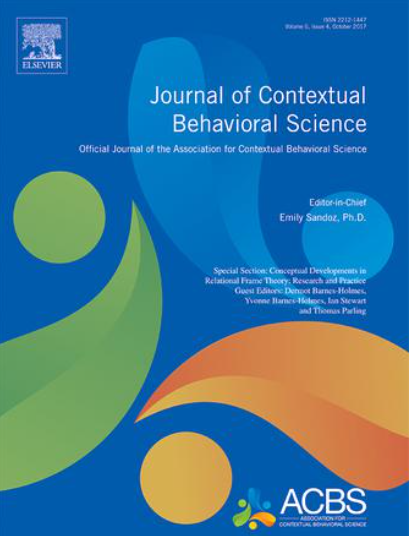Psychometric investigation of the avoidance and inflexibility scale (AIS) for cocaine use
IF 3
3区 心理学
Q1 PSYCHOLOGY, CLINICAL
引用次数: 0
Abstract
With the increasing use of Acceptance and Commitment Therapy (ACT)-based interventions for cocaine use disorder (CUD), the present study aimed to evaluate the psychometric properties of the Avoidance and Inflexibility Scale (AIS) in the context of cocaine use. A total of 1007 participants, aged 18 to 65, who were seeking treatment for cocaine use, were recruited from an outpatient addiction clinic in Houston, Texas. The study examined the factor structure of the AIS, its associations with relevant psychological constructs, and a potential cutoff score for the scale. The results revealed a two-factor structure for the modified AIS among adults seeking treatment for CUD. The findings also support the validity of the AIS, demonstrating theory-consistent associations with key constructs such as depression, addiction severity, and impulsivity. Additionally, a cutoff score of 38.5 was identified, which can serve as a useful threshold for identifying individuals at higher risk for CUD. These results have important implications for the design and evaluation of interventions targeting cocaine use, providing a tool to assess psychological inflexibility and experiential avoidance.
可卡因使用回避和不灵活性量表(AIS)的心理测量学研究
随着可卡因使用障碍(CUD)的接受和承诺治疗(ACT)干预措施的使用越来越多,本研究旨在评估可卡因使用背景下回避和不灵活性量表(AIS)的心理测量特性。共有1007名参与者,年龄在18岁至65岁之间,他们正在寻求可卡因使用的治疗,他们是从德克萨斯州休斯顿的一家门诊成瘾诊所招募的。该研究考察了AIS的因素结构,它与相关心理构念的关联,以及量表的潜在临界值。结果显示,在寻求CUD治疗的成人中,改进的AIS具有双因素结构。研究结果也支持了AIS的有效性,证明了与抑郁、成瘾严重程度和冲动等关键结构的理论一致的关联。此外,确定了38.5分的临界值,这可以作为识别CUD高风险个体的有用阈值。这些结果对设计和评估针对可卡因使用的干预措施具有重要意义,为评估心理不灵活性和经验回避提供了工具。
本文章由计算机程序翻译,如有差异,请以英文原文为准。
求助全文
约1分钟内获得全文
求助全文
来源期刊

Journal of Contextual Behavioral Science
PSYCHOLOGY, CLINICAL-
CiteScore
8.50
自引率
18.00%
发文量
82
审稿时长
61 days
期刊介绍:
The Journal of Contextual Behavioral Science is the official journal of the Association for Contextual Behavioral Science (ACBS).
Contextual Behavioral Science is a systematic and pragmatic approach to the understanding of behavior, the solution of human problems, and the promotion of human growth and development. Contextual Behavioral Science uses functional principles and theories to analyze and modify action embedded in its historical and situational context. The goal is to predict and influence behavior, with precision, scope, and depth, across all behavioral domains and all levels of analysis, so as to help create a behavioral science that is more adequate to the challenge of the human condition.
 求助内容:
求助内容: 应助结果提醒方式:
应助结果提醒方式:


